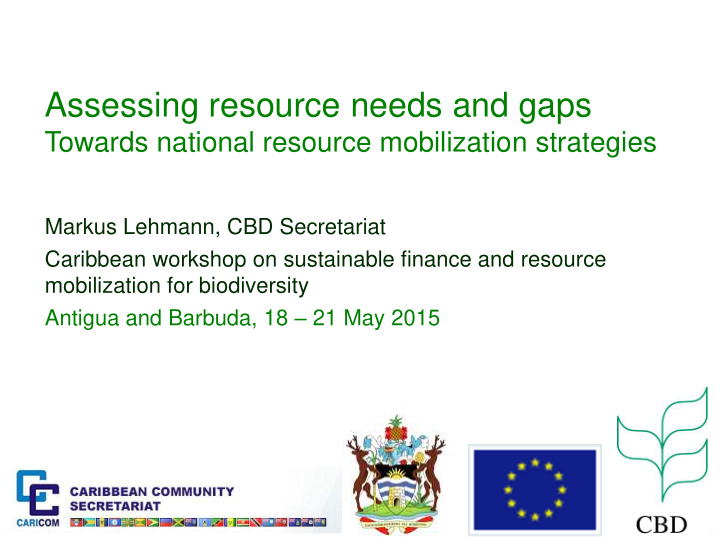



Assessing resource needs and gaps Towards national resource mobilization strategies Markus Lehmann, CBD Secretariat Caribbean workshop on sustainable finance and resource mobilization for biodiversity Antigua and Barbuda, 18 – 21 May 2015
The Global Context Article 20 of the Convention COP-10: Strategic Plan for Biodiversity 2011-2020 plus ‘implementation machinery’: review, update and revise, as appropriate, NBSAPs; Develop national target(s); Adopt revised NBSAPs as a policy instrument; Aichi Target 20 of the Strategic Plan for Biodiversity 2011- 2020: Substantial increase from the current levels by 2020, at the latest, of the mobilization of financial resources for effectively implementing the Strategic Plan for Biodiversity 2011-2020 from all sources… UNU-IAS gap analysis of existing NBSAPs: • many existing NBSAPs do not adequately address the mobilization of resources necessary for their implementation
COP-12: financial targets Adoption of financial targets, under Aichi Target 20: (decision XII/3): • Doubling international biodiversity-related funding flows to developing countries by 2015… • Inclusion of biodiversity in national priorities or development plans by 2015… • Reporting domestic biodiversity expenditures, as well as funding needs, gaps and priorities, by 2015 • Preparation of national financial plans for biodiversity by 2015 and assessment and/or evaluation of the values of biodiversity • Mobilize domestic financial resources from all sources to reduce the gap between identified needs and available resources at domestic level Adoption of a financial reporting framework for reporting by end of 2015
COP-12: financial targets Adoption of financial targets, under Aichi Target 20: (decision XII/3): Linkage to Aichi Target 2: By 2020, at the latest, biodiversity values have • Doubling international biodiversity-related funding flows to been integrated into national and local developing countries by 2015… development and poverty reduction strategies • Inclusion of biodiversity in national priorities or development plans and planning processes and are being by 2015… incorporated into national accounting, as • Reporting domestic biodiversity expenditures, as well as funding appropriate, and reporting systems. needs, gaps and priorities, by 2015 • Preparation of national financial plans for biodiversity by 2015 and assessment and/or evaluation of the values of biodiversity • Mobilize domestic financial resources from all sources to reduce the gap between identified needs and available resources at domestic level Adoption of a financial reporting framework for reporting by end of 2015
COP-12: financial targets Adoption of financial targets, under Aichi Target 20: (decision XII/3): • Doubling international biodiversity-related funding flows to developing countries by 2015… • Inclusion of biodiversity in national priorities or development plans by 2015… • Reporting domestic biodiversity expenditures, as well as funding needs, gaps and priorities, by 2015 • Preparation of national financial plans for biodiversity by 2015 and assessment and/or evaluation of the values of biodiversity • Mobilize domestic financial resources from all sources to reduce the gap between identified needs and available resources at domestic level Adoption of a financial reporting framework for reporting by end of 2015
COP-12: financial targets Adoption of financial targets, under Aichi Target 20: (decision XII/3): • Doubling international biodiversity-related funding flows to developing countries by 2015… • Inclusion of biodiversity in national priorities or development plans by 2015… • Reporting domestic biodiversity expenditures, as well as funding needs, gaps and priorities, by 2015 • Preparation of national financial plans for biodiversity by 2015 and assessment and/or evaluation of the values of biodiversity • Mobilize domestic financial resources from all sources to reduce the gap between identified needs and available resources at domestic level Adoption of a financial reporting framework for reporting by end of 2015
COP-12: financial targets Adoption of financial targets, under Aichi Target 20: (decision XII/3): • Doubling international biodiversity-related funding flows to developing countries by 2015… • Inclusion of biodiversity in national priorities or development plans by 2015… • Reporting domestic biodiversity expenditures, as well as funding needs, gaps and priorities, by 2015 • Preparation of national financial plans for biodiversity by 2015 and assessment and/or evaluation of the values of biodiversity • Mobilize domestic financial resources from all sources to reduce the gap between identified needs and available resources at domestic level Adoption of a financial reporting framework for reporting by end of 2015
Towards NBSAP finance plans
Towards NBSAP finance plans
Towards NBSAP finance plans
Towards NBSAP finance plans
Towards NBSAP finance plans
Reviewing existing expenditures Also consider relevant expenditures beyond environment ministries, based on NBSAP targets and priorities Actors: Other line ministries and agencies; NGO; foundations, academia, private sector Extra-budgetary allocations Consider expenditures that are harmful for biodiversity E.g. subsidies that provide incentives for excessive fertilizer use Consider opportunities for better alignment (‘mainstreaming biodiversity’)
Costing action plans From national targets and strategies to actions to cost items From “product breakdown structure” to “work breakdown structure” One-time vs recurrent costs: developing a time profile Use existing cost matrices Linkages to national budgeting/medium-term financial planning processes (e.g., MTEFs or similar)
Costing: example Target : impact of intensive agriculture is significantly reduced by 2020 Deliverable A: (…) Deliverable B : a training programme to help farmers transition to low-impact agricultural practices Best practices and guidelines Training curriculum Training of trainers (…) Deliverable C: (…) (…)
Costing: example
Costing example: Dominica NBSAP
Group work (by table) 1. Flesh out your preferred scenario by identifying key deliverables and associated actions. 2. Develop a simple cost profile. 3. How much could be covered by your budget/ how much could be covered by partners, and by whom? How much is the gap?
Recommend
More recommend